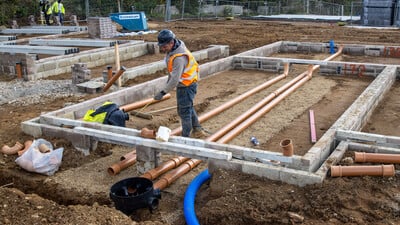Inspection chambers used on housing estates are traditionally made of concrete, but there are several good reasons why HDPE inspection chambers are a preferable option. Let’s take a look at them, starting with what an inspection chamber does.
Why are inspection chambers used for foul and surface water systems?
As the name suggests, an inspection chamber provides access to foul and surface water drains to inspect them for blockages and damage, but also for clearing out blockages. They are generally situated at the property line to allow access without disturbing the occupants.
On a housing estate, some inspection chambers may also serve multiple properties.
What are the advantages of HDPE inspection chambers over concrete?
HDPE inspection chambers weigh less than concrete
The weight of building materials is now a major consideration, as heavier weights increase the carbon footprint of transportation from the manufacturer to the building site and materials handling on the site itself.
The lighter weight of HDPE inspection chambers makes installation faster and safer
Weighing less also means they are easier, faster and safer to install than concrete. The immediate gains this brings to strict timeframes are clear, but it also brings benefits in reducing the risk of accidents at work and long-term musculoskeletal problems.
HDPE inspection chambers are cheaper than concrete
Combine the reduced costs of transportation, unloading and installation, HDPE offers a significant price advantage over concrete, saving up to £1000 per chamber.
HDPE inspection chambers are more resilient than concrete
While concrete is extremely strong, its rigidity can be a disadvantage. If excess pressure is applied to concrete it will eventually crack and if this happens, the inspection chamber will need to be replaced.
On the other hand, HDPE can take a remarkable amount of force and is more likely to deform and then return to its original shape rather than fail.
HDPE chambers are strong enough for use on housing estates
An inspection chamber with a D400 rating can withstand the pressure of a 40-tonne vehicle. Vehicles weighing more than this are unlikely to be allowed access to a housing estate, so any higher rating would be excessive.
HDPE is recyclable
At the end of its service life, HDPE plastic can be ground down and reused for new plastic products, making it a more sustainable product than concrete.
Can HDPE inspection chambers be adopted?
One factor that developers look at when installing foul and surface water drainage systems on housing estates is whether they will be adopted by water companies.
While this requires confirmation from the local water company, HDPE inspection chambers are generally regarded as suitable for adoption if installed at depths of up to 3 metres.
How MuckStopper makes inspection chamber installation easier on housing estates
When a housing estate is being constructed, different aspects of the development progress at different rates. As drains and inspection chambers are often installed long before groundworks and surfacing are completed, this means that a lot of muck and site debris can find its way into the open chambers. Cleaning this out is messy, time-consuming and expensive, particularly if the muck travels beyond the chamber and blocks the drains.
MuckStopper from Drainfast is a fast, easy way to prevent this from happening. Placed into the inspection chamber while it is being installed, MuckStopper features a central basket that collects muck and debris, while brushes around its perimeter create a close seal with the edge of the chamber that allows only water to drain through. Once groundworks and surfacing around the inspection chamber are completed, the MuckStopper is simply lifted out of the chamber, bringing all the muck and debris with it, and the chamber cover can be installed. The MuckStopper can then be quickly cleaned before being redeployed to another inspection chamber elsewhere on the estate.
We hope you have found this information helpful and interesting. If you have any further questions you are always welcome to call the friendly team of drainage experts at Drainfast on 01420 555600 or email [email protected].
Also, look out for more articles in our ongoing series of blog posts, bringing you useful information, insights, guides and tips on all things drainage!

Written by
Mark Chambers
Marketing Manager
As Marketing Manager, Mark plays an active role in running strategic projects to increase our brand profile.


